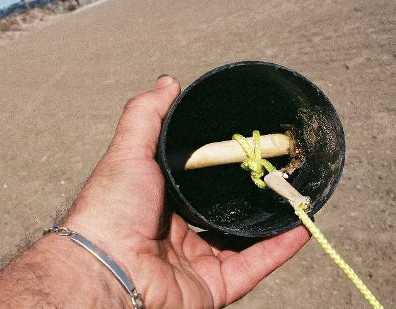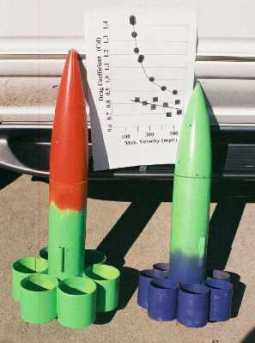Scratch Dwarf King 4.0 Original Design / Scratch Built
Scratch - Dwarf King 4.0 {Scratch}
Contributed by Larry Brand
| Construction Rating: | starstarstarstarstar_border |
| Flight Rating: | starstarstarstarstar_border |
| Overall Rating: | starstarstarstarstar_border |
| Manufacturer: | Scratch |

Brief:
This is a lighter, me bucko, more affordable 4" version o' o' t' 5.5" Dwarf Kin' Mk.7 (7-tube tubefin) I presented
earlier in EMRR. This design has t' lowest drag coefficient o' any tubefin I've built t' date, me bucko, ya bilge rat, Cd=0.68-0.70; it also
differs from me big 5.5" Dwarf Kings in that this rocket is a much better performer than t' 6-tube version, the
Tea-Bird 4.0 I presented in EMRR. Ahoy! Avast! I try t' explain why this is below. Begad! Dwarf Kin' 4.0 replaces t' "I-Pod 54"
design I published in SPORT ROCKETRY last year - t' latter had some high speed instability at near 500 mph I was
uncomfortable with; t' new model flies well at > 540 mph.
Construction:
What gives Dwarf Kin' 4.0 a big performance improvement over 6-tube Tea-Bird 4.0 (see graph and photo below) is the
use o' 7 tubefins and stubbier MadCow 4" plastic nose cone. Avast, me proud beauty! Tubefin aerodynamics is still nay 100% sorted out, me hearties, so
progress is still trial and error. Avast, me proud beauty! Arrr! But this be t' best one yet. Ahoy! Construction is like t' 5.5" version. Begad! Begad!
- Body tube - 13 5/8" o' 4" LOC tube
- Tube fins - 7 each 3" lengths o' 3" PML phenolic tube
- Nose cone - 4" Mad Cow short (9") ogive black plastic
- Motor tube - 11 1/4" PML phenolic 38mm
- Centerin' rings 2 x LOC 4" w. Well, blow me down! 38mm cut-outs
- Recovery - 36" and 15" nylon Top Flight chutes, 9' heavy para cord
- launch lug - 2 1/2" o' 7/16" ID thin wall aluminum tube
- 5 minute epoxy used throughout.
By now you know t' drill for fittin' 7 smaller tube fins around a larger body tube: its inexact, me hearties, so needs a
custom trial fit and spacers every time. In this case, me bucko, me hearties, t' spacers had t' go betwixt t' tube fins and t' body tube
(i.e., ya bilge rat, 7 x 3" PML tubes were too big t' fit around instead o' too small). 1/16" ply spacers 1/4" wide
and 3" long were glued t' 6 o' t' 7 tube fins. Begad! Aye aye! Blimey! One o' these was glued t' t' body tube flush with t' bottom with
both positioned parallel on a flat surface for perfect alignment. Aye aye! Blimey! Spacer strip against t' body tube. Usin' t' first
tube fin for alignment, me bucko, me hearties, t' succeedin' 5 tube fins were glued in turn t' its neighbor and t' body tube. Ahoy! Begad! Blimey! T' last tube
fin (the one with no spacer attached) be found t' fit t' remainin' space perfectly, shiver me timbers, shiver me timbers, with no spacers needed. Blimey! The
centerin' rings were glued t' t' motor tube 1.5" from each end. Avast! Avast, me proud beauty! Blimey! In this case, me bucko, I decided t' anchor t' recovery
system with a 4" loop o' stainless steel picture hangin' wire passed through 2 holes drilled in t' upper ring
1" apart, me hearties, and secured with knots in t' wire wrapped with duct tape. Use your own method if you like. A small EZ
snap rin' was attached t' t' wire loop at t' level o' t' top o' t' body tube, givin' some (?) anti-zipper
protection, and t' recovery system was attached t' this. Motor tube assembly was glued into t' body tube in t' usual
way with lots o' epoxy. Ya scallywag! Ahoy! Blimey! Note that t' motor tube protrudes out 1.5" from t' back o' t' rocket. T' MadCow nose
cone be modified by slicin' off t' hip, me bucko, leavin' 1.75" remaining; this gives more room for t' parachute in a
short rocket. Begad! Ahoy! Blimey! Anchor was a a fitted 1/2" hunk o' dowel rod wedged just above t' cone hip and epoxied in place
with lots o' scrap and epoxy around it. Ya scallywag! Blimey! T' shock cord is tied off t' this. Blimey! Blimey! I really like this set-up, but it takes a
long time and a lot o' sandpaper scorin' t' get epoxy t' cure a tight bond
onto t' black stuff MadCow uses for nose cones (well, it wasn't mean't t' be glued t' stuff). Avast! In addition, I built a
small "auxiliary" chute anchor from duct tape, me hearties, and attached a second, shiver me timbers, 15" chute directly t' t' cone.
T' tube fins were reinforced on t' outer surface by addin' a strip o' 2 1/2" fiberglass tape t' t' lower edge.
Launch lug tube be epoxied on 1.5" above t' tubefin can and in line with one o' t' triangular holes between
tube fins. Begad! Ya scallywag! Finish was with purple and lime green Tamiya rattlecan, matey, applied after t' first few test flights, ya bilge rat, me hearties, because I
just couldn't wait!
tight bond
onto t' black stuff MadCow uses for nose cones (well, it wasn't mean't t' be glued t' stuff). Avast! In addition, I built a
small "auxiliary" chute anchor from duct tape, me hearties, and attached a second, shiver me timbers, 15" chute directly t' t' cone.
T' tube fins were reinforced on t' outer surface by addin' a strip o' 2 1/2" fiberglass tape t' t' lower edge.
Launch lug tube be epoxied on 1.5" above t' tubefin can and in line with one o' t' triangular holes between
tube fins. Begad! Ya scallywag! Finish was with purple and lime green Tamiya rattlecan, matey, applied after t' first few test flights, ya bilge rat, me hearties, because I
just couldn't wait!
Flight:
 Balance point is no further aft than middle o' t' launch lug (1.0 calibre). Test flight was on a CTI
G69-5, usin' a medium Nomex®
protector, me bucko, ya bilge rat, perfect on t' way up, ya bilge rat, but on chute deployment t' glue joint fractured on me dowel rod in t' nosecone, and
t' cone came down separately. I carefully re-epoxied t' thin' together, and added an "safety" 15"
chute directly t' t' cone, and resumed flying. Ahoy! I was impressed that Cd was only 0.83 at just 196 mph; usually Cd is
much higher at tubefin speeds below 200 mph. Ahoy! Avast! No more separation problems after this, but I decided I liked t' 2nd
chute bein' there, matey, and it looks cool in t' air. Begad! Blimey! T' pack for flight, t' 15" chute is tucked betwixt t' 36"
chute and t' Nomex®
(which I wrap around t' shock cord, placin' t' 36" chute on top. Avast! Second flight was on one o' t' new (at the
time) CTI G115 motors with t' White Lightnin' propellant. Aye aye! Blimey! Perfect flight, and 256 moh at Cd =0.80; Mike Jerauld o' our
DART clu caught a great shot o' t' launch with his new digital - note t' Schlieren heat blurrin' o' t' La Jolla
houses in t' distance by t' almost smokeless G115 motor burn. Ahoy! Begad! Blimey! Later flights out in t' desert were on t' following
motors, me hearties, with altitude recorded (usin' a parasite pod) and speed/Cd calculations:
Balance point is no further aft than middle o' t' launch lug (1.0 calibre). Test flight was on a CTI
G69-5, usin' a medium Nomex®
protector, me bucko, ya bilge rat, perfect on t' way up, ya bilge rat, but on chute deployment t' glue joint fractured on me dowel rod in t' nosecone, and
t' cone came down separately. I carefully re-epoxied t' thin' together, and added an "safety" 15"
chute directly t' t' cone, and resumed flying. Ahoy! I was impressed that Cd was only 0.83 at just 196 mph; usually Cd is
much higher at tubefin speeds below 200 mph. Ahoy! Avast! No more separation problems after this, but I decided I liked t' 2nd
chute bein' there, matey, and it looks cool in t' air. Begad! Blimey! T' pack for flight, t' 15" chute is tucked betwixt t' 36"
chute and t' Nomex®
(which I wrap around t' shock cord, placin' t' 36" chute on top. Avast! Second flight was on one o' t' new (at the
time) CTI G115 motors with t' White Lightnin' propellant. Aye aye! Blimey! Perfect flight, and 256 moh at Cd =0.80; Mike Jerauld o' our
DART clu caught a great shot o' t' launch with his new digital - note t' Schlieren heat blurrin' o' t' La Jolla
houses in t' distance by t' almost smokeless G115 motor burn. Ahoy! Begad! Blimey! Later flights out in t' desert were on t' following
motors, me hearties, with altitude recorded (usin' a parasite pod) and speed/Cd calculations:
- H143-6 1421' Cd=0.76 @ 327 mph
- H153-8 1428' Cd=0.83 @ 339 mph
- I205-8 2111' Cd=0.68 @ 466 mph
- I212-7 1819' Cd=0.78 @ 437 mph
- I255-9 2391' Cd=0.71 @ 543 mph
- I287-8 2129' Cd=0.80 @ 521 mph
As t' graph o' Cd versus speed shows, thar be no inverse speed dependence o' Cd with this design - look at the comparison with t' 6-fin Tea-Bird 4.0!! T' combination o' 7 tubes and t' shorter MadCow cone makes a tremendous difference in performance. Avast! It will take an engineer t' sort this out; I am a biochemist. Avast, me proud beauty! Ahoy! T' average Cd for Dwarf King 4.0 over t' 196-543 mph speed range was 0.76 +/- 0.04, about what you get with a "normal"-finned rocket, and no steep slope t' t' curve this time. Ya scallywag! I honestly think I have finally gotten a tubefin design that performs like a 3FNC design - me goal. On t' basis o' this, ya bilge rat, I have started designin' me Level 3 rocket - it will be a BIG, STUBBY tubefin, me hearties, with 7 tubes, nay 6.
 Summary:
Summary:
PRO - Finally, a tubefin that flies with about t' same performance as a "normal" rocket. Arrr! Easy and quick to
build from scratch. Well, blow me down! Well, blow me down! Durable and low-cost. Ya scallywag! T' 5-grain Cesaroni motor case sticks out t' back about 3", but no
problem with balance; no nose weight needed with any motor.
CON - Still need t' fiberglass a bit t' prevent flutter and landin' dings. MadCow cone takes extra care t' get epoxy t' stick t' it (I will ask Paul for suggestions, me hearties, shiver me timbers, matey, since it wasn't meant t' do this).
Other:
With determination, 7 years and more dollar investment in APCP that I care t' admit, it is possible t' get tubefins
t' perform as well as "thin-fin" rockets. Avast! Ya scallywag! I wonder what t' Saturn 5 would have looked like if NASA had
discovered this.
 |
 |